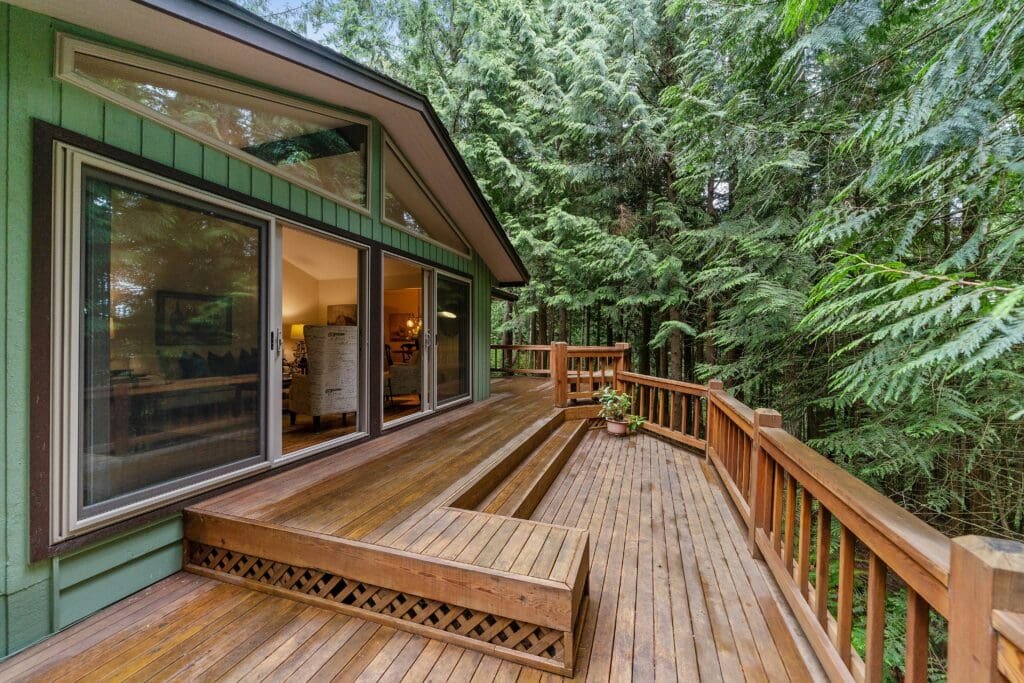
Best Deck Materials for Indiana Weather (2025 Guide)
Find the best deck materials for Indiana weather—capped composite, PVC, hardwoods, and more—compared for freeze–thaw cycles, humidity, UV, and maintenance so your deck lasts longer with less work.
Choosing the Best Deck Materials for Indiana Weather
If you’re searching “best deck materials for Indiana weather,” here’s the straight answer: capped composite and PVC deliver the best long-term performance for Indiana’s mix of freeze–thaw, humidity, summer sun, rain, and snow. Pressure-treated wood is the cheapest up front but needs consistent sealing. Dense hardwoods and modified woods can thrive with proper detailing. Aluminum is ultra-durable but has a distinctive look and feel. Below, you’ll get the why behind those picks plus install and maintenance guidance tailored to Indiana conditions.
Why Indiana Weather Is Tough on Decks
Indiana’s climate isn’t just “four seasons”—it’s rapid swings that stress materials, fasteners, and finishes. Moisture and temperature changes move boards and frames, while UV and wind-driven rain attack surfaces and joints. Understanding these forces helps you choose smart and build for the long haul.
- Freeze–thaw cycles expand and contract materials, loosening fasteners and opening joints
- High humidity and shade encourage mold and mildew if water can’t escape
- UV exposure fades color and breaks down unprotected finishes over time
- Wind-driven rain and snow exploit weak flashing and tight, unventilated joints
- Spring and fall swings stress composite gaps and wood grain differently
- Trapped debris and ice increase moisture load and surface slipperiness
How to Evaluate Materials for Indiana Conditions
Don’t just compare color chips; evaluate how each material manages water, movement, and UV, and how much ongoing care you’re willing to give it. Total cost of ownership, materials, labor, finishes, and time beats sticker price alone.
- Moisture and rot resistance in wet and shaded areas
- Dimensional stability across rapid temperature changes
- UV fade resistance and stain resistance in summer sun
- Slip resistance when wet, icy, or covered in pollen
- Maintenance cycles and product-specific cleaning requirements
- Total ownership cost over 10–20 years, not just day-one pricing
Capped Composite: The Indiana All-Rounder
Capped composites pair a composite core with a protective shell that resists moisture, stains, and fading. In Indiana’s freeze–thaw and humidity, that cap is a major advantage. Choose reputable brands with clear installation specs and don’t skimp on ventilation or fasteners.
- Prioritize capped (not uncapped) boards for stain and fade resistance
- Follow the manufacturer’s joist spacing and gapping for temperature swings
- Use compatible hidden fasteners and keep airflow under the deck
- Expect minimal upkeep beyond rinsing and gentle cleaning 1–2 times per year
PVC (Vinyl) Decking: Maximum Moisture Resistance
PVC is impervious to rot and highly resistant to stains and fading, which makes it ideal for shaded or tree-covered lots and lake-effect moisture. It expands and contracts more than wood, so installation details matter.
- Account for thermal movement with manufacturer-specified gaps
- Keep good under-deck ventilation to manage temperature and humidity
- Expect easy cleaning with mild soap and water; no sealing required
- Choose lighter colors for cooler barefoot comfort in July and August
Pressure-Treated Pine: Lowest Upfront Cost, Highest Upkeep
PT remains the budget go-to, but Indiana weather exposes shortcuts fast. If you choose PT, buy quality and commit to a finish schedule. Use ground-contact-rated lumber where needed and detail everything to shed water.
- Prefer KDAT (kiln-dried after treatment) when available for stability
- Seal the first warm season and re-coat every 2–3 years with a penetrating finish
- Leave proper side and end gaps to prevent cupping and surface checking
- Clean annually to remove mildew, pollen, and leaf stains
Cedar and Other Softwoods: Natural Beauty with Care
Cedar offers a beautiful, cooler-underfoot surface with natural resistance, but it still needs maintenance in Indiana’s humidity. To keep that warm tone, plan for regular finishing and stainless fasteners to avoid discoloration.
- Back-prime cut ends and keep boards ventilated above the frame
- Use stainless steel screws to prevent black streaking and staining
- Clean yearly and re-finish every 2–3 years for color retention
- Elevate above grade and avoid tight, debris-trapping gaps
Dense Hardwoods (Ipe, Cumaru): Premium Durability, Pro Detailing
Hardwoods are dense, stable, and long-lasting when detailed correctly. They suit homeowners who love natural wood and accept periodic oiling to preserve color. Pre-drilling and quality fasteners are non-negotiable.
- Use hidden fasteners or stainless screws with pre-drilled pilot holes
- Maintain ventilation and keep boards off damp soil for longevity
- Oil faces and cut ends annually if you want to retain the rich color
- Expect higher install costs but exceptional wear resistance
Modified Woods (Thermal/Acetylated): Wood Look, Better Stability
Heat- or chemically-modified woods improve stability and decay resistance, giving you a natural-wood aesthetic with fewer movement issues. Supply varies by brand, so follow finish guidance closely if you want to hold color.
- Confirm fastener compatibility and use stainless where recommended
- Ventilate the frame and avoid ground contact to limit moisture load
- Clean annually and re-coat every 2–3 years if maintaining color
- Expect mid-to-high upfront costs with lower movement than softwoods
Aluminum Decking: Ultra-Durable and Water-Shedding
Aluminum won’t rot, is non-combustible, and can double as a water-management system to create dry space below, great for second-story decks. The look and feel are distinct, so see it in person before you commit.
- Consider traction profiles for winter slip resistance and bare feet
- Plan for thermal movement with brand-specific clip systems
- Rinse as needed; coatings typically resist fading and stains very well
- Integrate under-deck drainage for covered patios and storage below
Framing, Footings, and Hardware Matter as Much as Boards
The surface gets the credit, but Indiana weather attacks the frame first. Build the skeleton to outlast the skin and you’ll avoid expensive tear-offs later. Local inspectors will expect proper ledgers, flashing, and frost-depth footings.
- Extend footings below local frost depth (often 30–36 inches; confirm your county)
- Flash ledgers with continuous metal and a membrane behind the siding
- Use UC4B/UC4C ground-contact-rated posts and beams where required
- Choose stainless or hot-dip galvanized hardware compatible with treated lumber
- Maintain airflow under the deck to shed humidity and speed drying
- Seal end grain on cuts and add drip edges to minimize water uptake
Cost vs. Longevity in Indiana
Upfront price tags can be misleading. When you factor finishing, cleaning, and early replacement from rot or UV damage, capped composite, PVC, aluminum, and well-detailed hardwoods often win the 10–20-year cost-of-ownership race. PT and cedar can still be smart choices for tighter budgets or smaller builds if you commit to consistent maintenance.
Maintenance Schedules That Actually Work Here
A realistic care plan keeps surfaces safe and attractive while preventing expensive repairs. Set reminders on your calendar every spring and fall.
- Clean once or twice per year depending on shade, trees, and pollen
- Re-seal wood every 2–3 years with breathable, penetrating finishes
- Clear leaf litter before winter and avoid piling snow against rail posts
- Rinse off de-icing salts promptly and use sand for winter traction
Common Mistakes to Avoid
Most premature failures come from skipped details, not bad boards. Build to spec, allow for movement, and keep water moving away from wood.
- Using uncapped composites that stain and fade faster than capped boards
- Tight board spacing that closes up in humidity and traps water
- Skipping ledger flashing or mixing incompatible metals at fasteners
- Building too close to grade without ventilation and splash protection
- Ignoring manufacturer gap specs for Indiana temperature ranges
- Neglecting annual cleaning, which accelerates mildew and discoloration
Quick Picks for Typical Indiana Homes
If you want the shortest path to a good choice, match your goal to the material. Then verify with brand specs and your installer’s experience.
- Low-maintenance priority: capped composite or PVC with hidden fasteners
- Natural-wood look with longevity: dense hardwood or modified wood with ventilation
- Budget-conscious build: pressure-treated frame and surface with diligent sealing
- Shady or damp yards: PVC, capped composite, aluminum, or modified wood with airflow
Frequently Asked Questions On Best Materials For Indiana Weather
What is the single best deck material for Indiana weather?
For most homeowners, capped composite or PVC offers the best mix of durability, low maintenance, and weather resistance. Aluminum is outstanding for specific use cases like second-story decks with dry space below.
Can I start with pressure-treated and upgrade later?
Yes. Invest in a properly flashed, ventilated, code-compliant frame now. You can resurface with composite or PVC later if the structure remains sound.
Do I need special footings for freeze–thaw?
Footings must extend below the local frost line—often 30–36 inches in many Indiana jurisdictions. Check your county’s requirement before you dig.
Will composite or PVC get too hot in summer?
Darker colors run warmer in direct sun. Choose lighter tones, add shade, and look for textured surfaces to improve barefoot comfort.
Do hardwoods like ipe make sense in Indiana?
They can be excellent with proper ventilation and stainless fasteners. Plan on periodic oiling if you want to preserve color rather than let it silver naturally.
What’s the best material for a shaded, damp yard?
Capped composite, PVC, aluminum, or modified woods handle moisture better than untreated softwoods when debris and shade are common.

Need further assistance?
Unsure about something? Get in touch with us for a personalized consultation.
Ready to Build a Deck That Handles Indiana Weather?
Get expert guidance on materials that actually last in freeze–thaw, humidity, and summer sun. We’ll inspect your site, recommend the right board and fastener system, and deliver a clean, durable build.
: • Free local estimate • Materials matched to Indiana climate • Fast, professional installation • Warranty and clear communication
Serving Terre Haute, Clinton, Rockville, and surrounding areas.